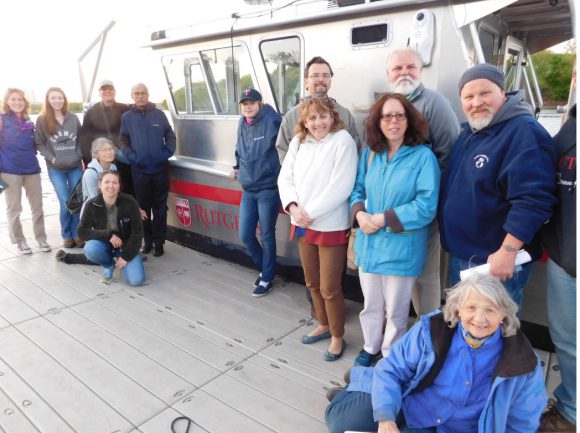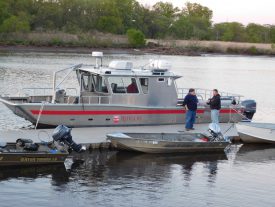
Rutgers Environmental Stewards from Middlesex County at the R/V Rutgers.
By Michele Bakacs, Rutgers Cooperative Extension, County Agent II/Associate Professor
Reprinted from Green Knight newsletter, May 2017
As the 2017 Rutgers Environmental Steward classes entered their final month, and with the warm weather upon us, the Middlesex County class took to the water. On May 3, Stewards got a rare opportunity to see the Raritan River up close by taking a two-hour boat trip on the new R/V Rutgers. The R/V Rutgers is a new boat operated by the Department of Marine and Coastal Sciences. This 36 ft. (11 meter) aluminum landing craft is a 20-passenger vessel and supports a wide range of educational and scientific needs such as trawling, grab sampling, diving, water profiling, coring, autonomous underwater vehicle operations, etc. Faculty can reserve the vessel so students can get a firsthand look at the Raritan River ecosystem and the human impacts to the watershed.
This is part of a larger effort by the Rutgers Collaborative for Research and Education to “Bring the River to your classroom” and works to support faculty efforts in engaging students and the community in Raritan River data and science through data activities.

The R/V Rutgers at the Class of 1914 Boathouse dock in New Brunswick.
The Rutgers Environmental Stewards program trains volunteers on important environmental issues affecting New Jersey and helps them make a difference in their own communities. The program consists of 60 hours of classes offered around the state on topics including habitat protection, climate change, geology, soil health, alternative energy, invasive plants, environmental policy, pollinators, and much more. Stewards complete a 60-hour internship of their choosing in order to become certified. Optional fieldtrips are included. Anyone can become an Environmental Steward regardless of background.
The Stewards met the boat in Boyd Park in New Brunswick at the Class of 1914 Boathouse and were welcomed by the boat’s captain Chip Haldeman, and first mate Nicole Waite. Joining us on our trip was Heather Fenyk, director of the Lower Raritan Watershed Partnership, and Jean Marie Hartman, professor in the Department of Landscape Architecture. Heather and Jean Marie provided a rich history of the Raritan and identified points of interest including shale outcrop geologic formations, the Lenape Trail connection to the River, noted flora and fauna, as well as the industrial legacy of contaminated sites, old factories, and the Edgewater Landfill.
First mate Nicole taught the Stewards how researchers monitor water quality and trained them on collecting data using YSI water monitoring probes to test for dissolved oxygen, pH, temperature, and salinity. We also saw two bald eagles, countless ospreys, cormorants, and vast marshland. The salt marshes are mostly dominated by Phragmites australis, an invasive grass known as common reed, but we also saw native Spartina alterniflora (salt marsh cordgrass) holding its own at the fringes of the saltmarshes.
Overwhelmingly the Stewards walked away with a new appreciation of this fantastic natural resource that most of us take for granted. Most people see the Raritan River as a place to avoid, to view from afar from the Garden State Parkway or Route 1 bridge. This experience helped the Stewards better understand the river that lies in the heart of their community, and the importance of making sure it is cleaned up and protected.

